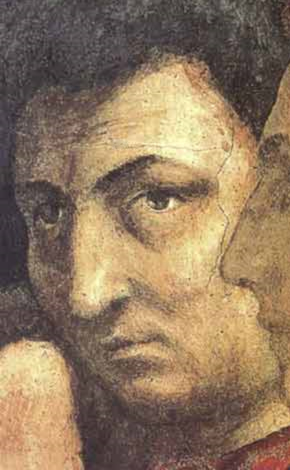
Born: 21 December 1401, Florence
Died: Latter half of 1428 (aged 26)
Period: Early Renaissance
The Life of Tommaso Cassai Masaccio
Tommaso di Ser Giovanni di Simone, known as Masaccio (1401–1428), was a pivotal figure in the early Renaissance whose innovative approach to art marked a departure from the Gothic style that dominated the era. Born in Castel San Giovanni (now San Giovanni Valdarno, Tuscany), Masaccio is celebrated for his mastery of perspective, realistic depiction of human figures, and the use of light to create depth, which profoundly influenced the course of Renaissance art.
Early Life and Training Little is documented about Masaccio’s early life, but it is known that he moved to Florence, where he likely received his artistic training. In Florence, he would have been exposed to the works of Giotto, whose emphasis on volume and form over the decorative details of the International Gothic style had a lasting impact on Masaccio.
Artistic Contributions Masaccio’s career was short-lived, as he died at the young age of 27, but his contributions during this brief period were monumental. One of his most significant works is the Brancacci Chapel frescoes in the Church of Santa Maria del Carmine in Florence. These frescoes, particularly “The Tribute Money,” demonstrate Masaccio’s use of linear perspective, a technique that was revolutionary at the time, and his ability to imbue his figures with a sense of gravity and emotional depth. His figures are robust and three-dimensional, occupying a convincingly rendered space, and they interact with a naturalism previously unseen in European art.
Influence and Legacy Masaccio’s work in the Brancacci Chapel became a crucial training ground for future Renaissance artists, including Michelangelo and Leonardo da Vinci, who studied his frescoes to learn the fundamentals of perspective and figure composition. His emphasis on naturalism, as opposed to the stylized forms of the International Gothic, heralded a new era in painting that sought to represent the observable world and the human condition with greater fidelity.
Death and Aftermath The circumstances of Masaccio’s death in Rome in 1428 remain a mystery, but his legacy was secured by the profound impact of his work on subsequent generations of artists. Despite the brevity of his career, Masaccio is regarded as one of the titans of Renaissance art, his innovations laying the groundwork for the achievements of Renaissance painting in the 15th and 16th centuries. Through his mastery of perspective and human anatomy, Masaccio played a key role in the shift towards a more realistic and human-centered approach to art, marking the dawn of the Renaissance in painting.
Tommaso Cassai Masaccio’s Notable Works
Masaccio, a seminal figure in early Renaissance painting, is celebrated for his groundbreaking contributions to the development of perspective, naturalistic representation of the human figure, and the use of light and shadow. Although his career was brief, his work left an indelible mark on the trajectory of Western art. Here are ten of Masaccio’s most famous and influential works:
- “The Tribute Money” (c. 1425) – Part of the frescoes in the Brancacci Chapel, this painting is renowned for its use of linear perspective and chiaroscuro to create a three-dimensional space and for its depiction of a narrative from the life of Saint Peter.
- “The Expulsion from the Garden of Eden” (c. 1425) – Also in the Brancacci Chapel, this fresco captures the emotional turmoil of Adam and Eve as they are expelled from Eden, noted for its realism and expressive power.
- “The Holy Trinity” (c. 1427) – Located in the Santa Maria Novella in Florence, this fresco is celebrated for its mastery of perspective, depicting the Trinity in a coffered, barrel-vaulted chapel, and is considered a milestone in the use of perspective in art.
- “The Baptism of the Neophytes” (c. 1425) – Another fresco from the Brancacci Chapel, showcasing Masaccio’s skill in portraying the human figure in wet drapery and his understanding of emotional expression.
- “Saint Jerome and Saint John the Baptist” (c. 1428) – Housed in the National Gallery of Art in Washington, D.C., this panel painting demonstrates Masaccio’s ability to render the human figure with a sense of volume and solidity.
- “The Madonna and Child with Saint Anne” (c. 1424) – Attributed to Masaccio, this painting is significant for its depiction of the Virgin and Child with St. Anne, showcasing the artist’s use of light and shadow to create depth.
- “Crucifixion” (c. 1426) – Part of the Pisa Altarpiece, this work highlights Masaccio’s ability to convey the gravity and sorrow of the crucifixion through the use of light and composition.
- “Saint Paul” (c. 1426) – Also from the Pisa Altarpiece, this painting exemplifies Masaccio’s skill in portraiture and his understanding of anatomical realism.
- “The Healing of the Cripple and the Raising of Tabitha” (c. 1425) – Located in the Brancacci Chapel, this fresco illustrates two miraculous stories side by side, showcasing Masaccio’s innovative narrative style and his use of perspective.
- “The Madonna with Child” (c. 1426) – Known as the “Pisa Madonna,” this work demonstrates Masaccio’s talent for depicting intimate, sacred moments with realism and tenderness.
Despite his early death, Masaccio’s work profoundly influenced the direction of Renaissance art, laying the foundation for future generations to build upon. His frescoes, in particular, remain a testament to his innovative spirit and his mastery of the techniques that would define Renaissance painting.